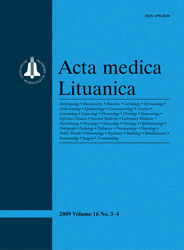Acta medica Lituanica
 ISSN 1392-0138 ISSN 2029-4174 (online) |
2011 m. Nr. 4 Phenotypic variation and genetic polymorphism of low-density lipoprotein exon 4 receptor gene among Jordanian familial hypercholesterolemia patients
Purpose. The aim of this study was to measure lipid profiles among severe and mild familial hypercholestrolemic (FH) patients and to screen unrelated families for LDL receptor (LDLR) gene polymorphism.
Methods. Fifteen FH patients and six controls were enrolled in the study. Total cholesterol (CH), triglyceride (TG), high-density lipoprotein (HDL-cholesterol), low-density lipoprotein (LDL) and ApoB-100 levels were measured spectrophotometrically. Patients were classified clinically into severe and mild, based on lipid profile phenotype and the presence of cardiovascular manifestation at the age of disease onset. Low-density lipoprotein exon 4 receptor gene polymorphism was screened by the SSCP method. Results. FH severe phenotype patients had significantly higher total cholesterol levels (14.34 ± 1.14) mmol/L as compared with mild FH phenotype (10.13 ± 1.23 mmol/L) and experienced earlier symptoms in the childhood (9.25 ± 3.22) years as compared with those of mild phenotype, who did not experience symptoms until the mid of the fourth decade of life (36.7 ± 5.25 years). No significant difference was found between HDL-cholesterol, LDL-cholesterol, ApoB-100 among severe FH as compared with mild FH patients. All FH pedigrees showed the autosomal dominant mode of inheritance. SSCP results showed a wide spectrum of LDL exon 4 gene polymorphism among severe and mild phenotypes, which differed from control. Conclusions. There are statistical differences between severe and mild phenotype FH patients in total cholesterol, triglyceride and the age of biological expression among FH Jordanians. FH patients showed a wide spectrum of gene polymorphism within the LDLR exon 4 gene. These polymorphisms were different among FH families; this may be related to founder factors, such as the degree of consanguinity among FH patients’ parents and shed light on the importance of the role of genetic screening and counseling in reducing the risk of occurrence of the new severe FH phenotypes that develop severe complications early in life and need LDL aphresis, as well as on the importance of cascade screening to trace and identify people at genetic risk, using family tracing, for an early diagnosis of the mild FH phenotypes that can be treated with lipid lowering therapy and life style changes early to prevent later cardiovascular complications. Keywords: familial hypercholesterolemia, low-density lipoprotein, receptor, homozygous, heterozygous, SSCP, Apo B-100 |
Issues:
2011 - Vol.18 No. 1, No. 2, No. 3, No. 4 2010 - Vol.17 No. 1-2, No. 3-4 2009 - Vol.16 No. 1-2, No. 3-4 2008 - Vol.15 No. 1, No. 2, No. 3, No. 4 2007 - Vol.14 No. 1, No. 2, No. 3, No. 4 2006 - Vol.13 No. 1, No. 2, No. 3, No. 4 2005 - Vol.12 No. 1, No. 2, No. 3, No. 4 2004 - Vol.11 No. 1, No. 2, No. 3, No. 4 2003 - Vol.10 No. 1, No. 2, No. 3, No. 4 2002 - Vol.9 No. 1, No. 2, No. 3, No. 4 2001 - Vol.8 No. 1, No. 2, No. 3, No. 4 |